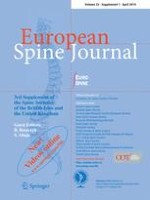Published in:

01-04-2014 | Original Article
The lumbar spine has an intrinsic shape specific to each individual that remains a characteristic throughout flexion and extension
Authors:
Anastasia V. Pavlova, Judith R. Meakin, Kay Cooper, Rebecca J. Barr, Richard M. Aspden
Published in:
European Spine Journal
|
Special Issue 1/2014
Login to get access
Abstract
Purpose
We have previously shown that the lumbar spine has an intrinsic shape specific to the individual and characteristic of sitting, standing and supine postures. The purpose of this study was to test the hypothesis that this intrinsic shape is detectable throughout a range of postures from extension to full flexion in healthy adults.
Methods
Sagittal images of the lumbar spine were taken using a positional MRI with participants (n = 30) adopting six postures: seated extension, neutral standing, standing with 30, 45 and 60° and full flexion. Active shape modelling (ASM) was used to identify and quantify ‘modes’ of variation in the shape of the lumbar spine.
Results
ASM showed that 89.5 % of the variation in the shape of the spine could be explained by the first two modes; describing the overall curvature and the distribution of curvature of the spine. Mode scores were significantly correlated between all six postures (modes 1–9, r = 0.4–0.97, P < 0.05), showing that an element of intrinsic shape was maintained when changing postures. The spine was most even in seated extension (P < 0.001) and most uneven between 35 and 45° flexion (P < 0.05).
Conclusions
This study shows that an individual’s intrinsic lumbar spine shape is quantifiable and detectable throughout lumbar flexion and extension. These findings will enable the role of lumbar curvature in injury and low back pain to be assessed in the clinic and in the working and recreational environments.